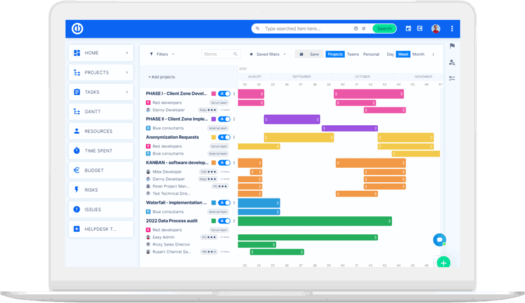Redmine erabili eta konfiguratu Debian 9an
Redmine-ek proiektu-txostenak, wikiak, sistemaren jarraipen-arazoak, elkarrizketak, egutegiak, posta jakinarazpenak eta askoz gehiago barne hartzen ditu. Gure gidari honek erakutsiko dizu nola instalatu eta pertsonalizatu Redmine-ren bertsio berria Debian 9-an.

Before you start make sure to do this
- Have a domain name pointing to a public IP on your server. We're going to utilize example.com.
- Signed in as a sudo-favored client.
- Introduced. Nginx
- Have a Domain SSL declaration introduced.
Make a My SQL database
Redmine underpins MySQL/MariaDB, SQL Server, SQLite 3, Microsoft and PostgreSQL. We will utilize MariaDB as back-end to the database. Check that you have introduced at any rate MySQL 5.7 or MariaDB 10.3 on your PC.
In the event that your Debian server doesn't have MariaDB or MySQL, you can introduce it utilizing these guidelines.
Start by signing in by composing in the MySQL support:
$ sudo mysql
To make another database, run the accompanying SQL explanation;
mysql> CREATE DATABASE redmine CHARACTER SET utf8mb4;
Make another client represent MySQL, and permit access to the database:
mysql> GRANT ALL ON redmine.* TO 'redmine'@'localhost' IDENTIFIED BY 'change-with-strong-password';
mysql> flush priviledges; <- this is important! Otherwise, the changes will not apply till the mysql service restart.
Remember to change a solid secret key with change-with-solid passwords.
Once done, log out of the console at MariaDB by typing:
mysql> EXIT;
Install Ruby
Install the latest version of Ruby by means of Rbenv or RVM.
RVM
1. install rvm, run it, add to autostart
curl -sSL https://get.rvm.io | sudo bash -s master
source /etc/profile.d/rvm.sh
echo '[[ -s "/etc/profile.d/rvm.sh" ]] && source "/etc/profile.d/rvm.sh"' >> ~/.bashrc
2. Create user "easy" (or you may name it as you wish, the point is, this user will work with your redmine application, not root user. It should be done for security reasons)
useradd -m -G rvm -s /bin/bash easy
Also you need to add user "easy" to sudoers group (we should allow to this user to run some commands from sudo)
usermod -a -G sudo easy
If you did this you may miss the next step, because after this command your user is in the proper group already. Switch to this user
su - easy
3. add user to rvm group
usermod -a -G rvm easy
Also you need to add user "easy" to sudoers group (we should allow to this user to run some commands from sudo)
usermod -a -G sudo easy
Switch to user "easy"
su - easy
4. install ruby
rvm install 2.6 --patch railsexpress
5. install git
sudo apt-get install git
6. set ruby 2.6 as default
rvm use 2.6 --default
Part in italic is needed only if you are going to install ruby from non-root user. If you decide to leave it, you may replace user name "easy" to "redmine".
Rbenv
Please follow the instructions in this article.
Introduce Passenger and Nginx #
Passenger is a quick, lightweight Ruby, Node.js, and Python web application server that can be incorporated with Apache and Nginx. Passenger will be introduced as Nginx module.
Installing the packages required to make an https repository:
$ sudo apt install dirmngr gnupg apt-transport-https ca-certificates software-properties-common
Import the GPG key repository and allow the Phusionpassenger repository to:
$ sudo apt-key adv --recv-keys --keyserver hkp://keyserver.ubuntu.com:80 561F9B9CAC40B2F7
$ sudo add-apt-repository 'deb https://oss-binaries.phusionpassenger.com/apt/passenger stretch main'
Update the list of packages and install the Nginx Passenger Modul with:
$ sudo apt update
$ sudo apt install libnginx-mod-http-passenger
$ gem install passenger --no-ri --no-rdoc
$ passenger-install-nginx-module
Install Redmine on Debian
Start by installing the necessary dependencies to build a Redmine:
$ sudo apt install build-essential libmariadbclient-dev imagemagick libmagickwand-dev curl ruby-dev libxslt-dev libxml2-dev zlib1g-dev
You should check the Redmine download page for a newer version before proceeding with the next step.
Download Redmine
Use the following curl command to download the archive at Redmine:
$ sudo curl -L http://www.redmine.org/releases/redmine-4.0.4.tar.gz -o /tmp/redmine.tar.gz
Extract the archive and transfer it to /opt directory once the download is complete:
$ cd /tmp
$ sudo tar zxf /tmp/redmine.tar.gz
$ sudo mv /tmp/redmine-4.0.4 /opt/redmine
Configure Redmine Database:
Copy the configuration file for an example in Redmine:
$ sudo cp /opt/redmine/config/database.yml.example /opt/redmine/config/database.yml
Open your Text editor file:
$ sudo nano /opt/redmine/config/database.yml
Search the production section, and enter the previously created MySQL database and user information:
/opt/redmine/config/database.yml
Production:
adapter: mysql2
database: redmine
host: localhost
username: redmine
password: "change-with-strong-password"
encoding: utf8
Save the file until done, and exit the editor.
Install Ruby conditions
Install bundler and other Ruby conditions and explore to the Redmine catalogue:
$ cd path/to/redmine/
$ sudo gem install bundler
$ sudo bundle install -- without development test
Relocate the database by Generating Keys:
Run the accompanying key age order, and relocate the database.
$ sudo bundle exec rake generate_secret_token
$ sudo RAILS_ENV=production bundle exec rake db:migrate
Set the correct approvals
Nginx runs as a client and network of the www-information. Set authorizations accurately by giving the accompanying chown order.
$ sudo chown -R www-data: /opt/redmine/
Setup Nginx
Note: In this blog, you can learn more about letsencrypt as well as an alternative way to create/purchase HTTPS certificates (cert-manager).
By now, if you don't check the prerequisites for this tutorial you should already have Nginx with an SSL certificate installed on your system.
Open your Text Editor and create the following block file for Nginx server:
$ sudo nano /etc/nginx/sites-available/example.com
/etc/nginx/sites-available/example.com
# Redirect HTTP -> HTTPS
server {
listen 80;
server_name www.example.com example.com;
include snippets/letsencrypt.conf;
return 301 https://example.com$request_uri;
}
# Redirect WWW -> NON WWW
server {
listen 443 ssl http2;
server_name www.example.com;
ssl_certificate /etc/letsencrypt/live/example.com/fullchain.pem;
ssl_certificate_key /etc/letsencrypt/live/example.com/privkey.pem;
ssl_trusted_certificate /etc/letsencrypt/live/example.com/chain.pem;
include snippets/ssl.conf;
return 301 https://example.com$request_uri;
}
server {
listen 443 ssl http2;
server_name example.com;
root /opt/redmine/public;
# SSL parameters
ssl_certificate /etc/letsencrypt/live/example.com/fullchain.pem;
ssl_certificate_key /etc/letsencrypt/live/example.com/privkey.pem;
ssl_trusted_certificate /etc/letsencrypt/live/example.com/chain.pem;
include snippets/ssl.conf;
include snippets/letsencrypt.conf;
# log files
access_log /var/log/nginx/example.com.access.log;
error_log /var/log/nginx/example.com.error.log;
passenger_enabled on;
passenger_min_instances 1;
client_max_body_size 10m;
}
Don't forget to use your Redmine domain to replace example.com and set the correct path to the SSL certificate files. All requests for HTTP will be forwarded to HTTPS. This guide generates the snippets used in this setup.
Enable the block server by creating a symbolic link to the directory-enabled for the sites:
$ sudo ln -s /etc/nginx/sites-available/example.com /etc/nginx/sites-enabled/
Make a test before restarting the Nginx service to be sure there are no syntax errors:
$ sudo nginx -t
If no errors occur then the output should look like this:
nginx: the configuration file /etc/nginx/nginx.conf syntax is ok
nginx: configuration file /etc/nginx/nginx.conf test is successful
Finally, restart the service with Nginx by type in:
$ sudo systemctl restart nginx
Access Redmine
Open your browser, type your domain, and if the installation is successful, a similar screen will appear as follows: 
Redmine 's default login credentials are to:
User name: admin
Password: admin
When you first sign in, you'll be prompted to change your password as shown below: 
Once the password is changed you will be redirected to the user account page.
You built Redmine on your Debian system with success.

Redmine eguneraketa azkena? Erraza.
Lortu proiektu planifikazio, kudeaketa eta kontrol osoa egiteko tresna indartsuak software bakar batean.
